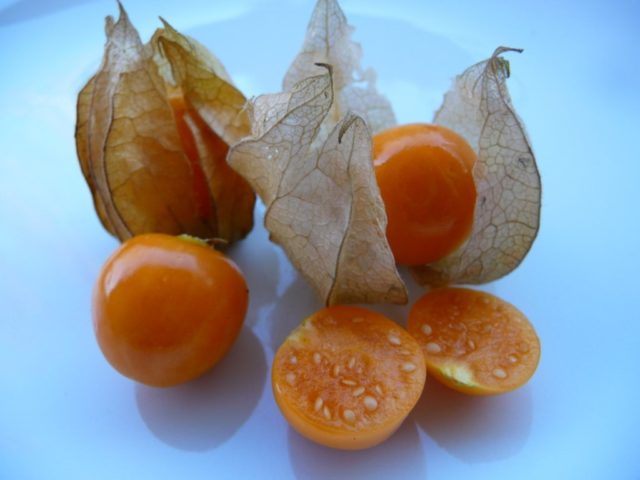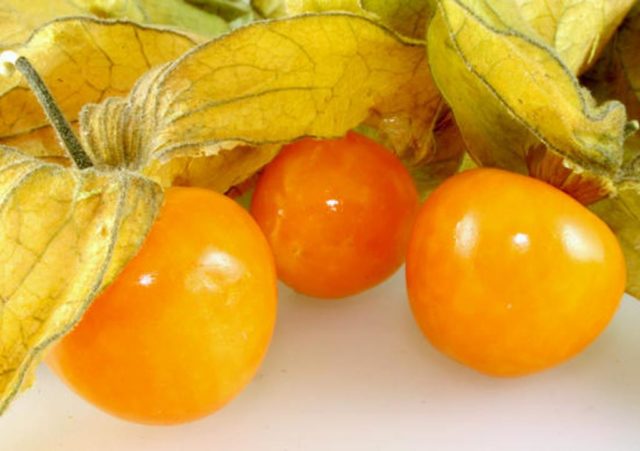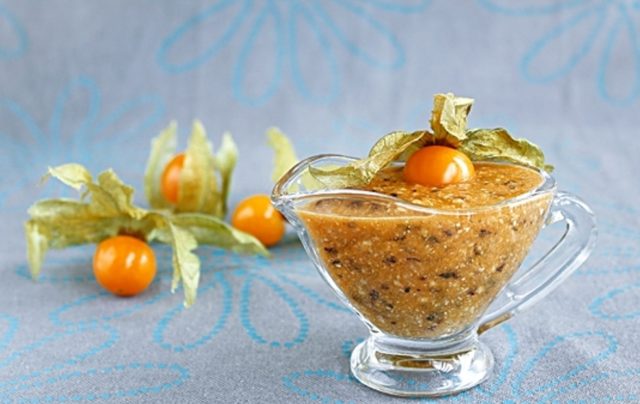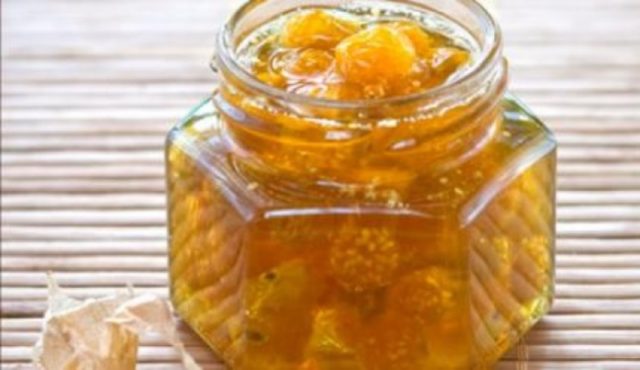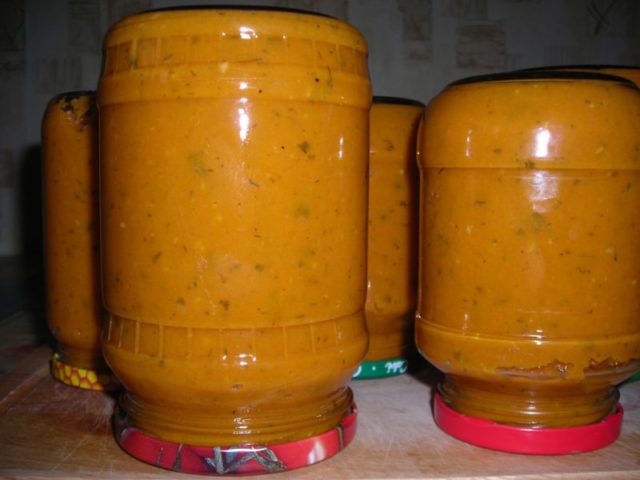Content
Physalis is the largest species of the nightshade family. In the common people, it has the name emerald berry or earthen cranberry. A characteristic feature of the plant is a fruit-berry in a bright case of sepals, reminiscent of a Chinese lantern. Many gardeners grow a crop to decorate their personal plot, not knowing that the beneficial properties of physalis have been studied for a long time, and it is widely used in folk medicine.
Physalis is a berry or fruit
Growing an emerald berry on a personal plot, many gardeners are wondering if physalis is a fruit, berry or vegetable. In appearance, the fruits are similar to cherry tomatoes of yellow, red or orange color. In nature, there are 3 types: decorative, berry and vegetable.
The culture can be called a berry, fruit, flower and vegetable at the same time, it all depends on the variety and sugar content, and physalis can also be grown as an annual or perennial plant.
Vegetable physalis is a shade-tolerant, frost-resistant plant. The powerful shrub has yellow, green, or purple foliage. Ripe fruits are large, weighing up to 80 grams. The vegetable culture has a bitter taste; it is used for canning, making sauces, and is used as an addition to main courses.
Berry or strawberry physalis is a small plant with dark olive leaves and small bright orange fruits. The berry has a sweet or sweet and sour taste. Used for making jam, compote, candied fruits and raisins.
Ornamental type is a popular plant designed to decorate a personal plot. There are tall and undersized varieties, emerald and crimson color. Lantern flowers are colored orange, lemon or hazel. Decorative physalis is widely used in floristry. Cut flowers will be a good addition to your winter bouquet.
Physalis is a berry, fruit, vegetable or flower, there is no difference, the main thing is to grow a healthy, strong plant, you need to make a minimum of care and cultivation efforts.
Is it possible to eat physalis
There are 2 types of edible physalis: vegetable or Peruvian gooseberries and berry or strawberries. Due to the high content of ascorbic acid, B vitamins and other useful substances, physalis is widely used in cooking and folk medicine.
Physalis is somewhat reminiscent of tomatoes. It can be eaten straight from the garden, used for making preserves and jams, and salted and harvested for the winter.
It must be remembered that physalis has poisonous leaves and a bright orange shell. Therefore, when preparing infusions and decoctions, it is necessary to strictly observe the dosage and consult a specialist before use.
Taste qualities
Edible physalis species are perennials, but in our latitudes the culture is grown as an annual. The plant is gaining fame all over the world for its good taste and beneficial properties.
Berry physalis is more popular than vegetable physalis and comes in several varieties with a variety of flavors:
- Raisin - has a sweet taste. The berry is dried and used instead of raisins.
- Peruvian or strawberry - small fruits with a sweet and sour taste, reminiscent of strawberries.
- Florida - the variety has delicious sweet fruits.There is one drawback - they do not exude aroma.
Physalis vegetable is represented by one Mexican species, which has a large number of varieties. Most popular:
- Confectioner - a highly branched plant with large sour fruits.
- Kinglet - medium-sized bush with light lemon fruits of sweet and sour taste.
- Ground Gribovsky - an upright plant strewn with light olive fruits with a characteristic sweet and sour taste. The variety is suitable for growing in all regions of Russia.
How physalis is useful for humans
Physalis is a tasty and healthy berry. The beneficial properties have been known for a long time. Physalis was discovered by the tribes of South and Central America several millennia ago. Modern scientists have studied culture for a long time and came to the general opinion that physalis has positive properties and contraindications:
- It contains a large amount of ascorbic acid, due to which the berry accelerates the recovery of the body after infectious diseases.
- Nicotinic acid gets rid of "bad" cholesterol.
- B vitamins normalize the functioning of the nervous system.
- Potassium and magnesium strengthen the heart muscle and remove excess fluid from the body.
- Beta-carotene and lycopene inhibit the formation of cancer cells.
- Fiber removes toxins and toxins, improves intestinal motility.
- The juice heals wounds and burns, smoothes old scars and scars.
Physalis has diuretic, choleretic, anti-inflammatory, analgesic properties.
Fresh berries or a medicine prepared on the basis of physalis are recommended to be taken with:
- kidney disease;
- cholecystitis;
- Botkin's disease;
- rheumatism;
- hypertension;
- after surgery.
The plant will benefit those who are on a diet. Since it contains dietary fiber that normalizes the bowel function. The culture contains vitamins, trace elements, phytoncides and acids that are necessary for a healthy lifestyle. Fruits remove fluid and toxins from the body.
Physalis is widely used in cosmetology. Due to the high copper content, the skin is smoothed and velvety. Regular consumption of the fruit helps to get rid of wrinkles and pigmentation.
Physalis during pregnancy
Physalis, according to French beliefs, is a symbol of a long-awaited pregnancy. In ancient times, a woman who gave birth to a child presented her husband with a green branch as a token of gratitude for the conception.
Most pregnant women, having learned about the beneficial properties of the fruit, begin to use it in large quantities. Forgetting that physalis, like another plant, can bring not only benefits to the body, but also harm.
Physalis is a very strong allergen, its use can cause a strong allergic reaction in the form of rash, swelling and itching. This reaction can adversely affect the development of the fetus.
During pregnancy, a woman's blood pressure is unstable, and since the plant can reduce performance, you must be extremely careful when taking berries.
And also the culture has a diuretic. With severe edema, it is useful; when used with other drugs, there is a possibility of complete dehydration of the body, which will adversely affect the child.
How to use physalis
Physalis is used fresh and for the preparation of various dishes. When purchasing a product in a store, you must adhere to the rules:
- fruits are chosen in a closed, dry shell;
- green sepals are the first sign of immaturity;
- store the berry in a shell, in a dark, cool place for about a month;
- the cleaned product should only be in the refrigerator for no more than 10 days.
Cooking does not stand still, chefs from all over the world come up with more and more new recipes from berries, vegetables and fruits. Physalis is no exception. Here are some proven sweet and sour berry recipes.
Apples and physalis sauce
The seasoning goes well with pork chops.
Ingredients:
- berry - 250 g;
- sweet apples - 2 pcs.;
- lemon juice - 30 ml;
- apple juice - ½ tbsp.;
- coriander, curry - ½ tsp each;
- honey - 1 tsp;
- salt and pepper to taste.
Performance:
- The apples are peeled and seeds, cut into small wedges and fried in butter.
- Physalis is sorted out, washed, cut in half and sent to the apples. Fry until the fruit is golden brown.
- Pour in apple and lemon juice and simmer over low heat for 10-15 minutes.
- Softened apples and physalis are crushed in a blender until puree.
- Add honey, spices and leave to simmer for another 5 minutes.
- The dish is ready, bon appetit.
Jam
Delicious, healthy delicacy will warm you on cold winter evenings.
Ingredients:
- berry - 1 kg;
- water - half a liter;
- granulated sugar - 1200 g.
Preparation:
- Physalis is washed and each berry is pierced with a toothpick.
- Syrup is prepared from water and 500 g of sugar.
- Pour the berry with hot syrup and leave to infuse overnight.
- In the morning, put the pan on a small fire, add the remaining sugar and cook until the desired thickness.
- Hot jam is poured into prepared containers and, after cooling, is stored.
Caviar
The appetizer prepared according to this recipe tastes good and will be an unusual addition to meat dishes.
Ingredients:
- berry - 1 kg;
- onions - 0.3 kg;
- carrots - 0.8 kg;
- vegetable oil for frying;
- spices to taste.
Method of execution:
- Carrots are grated, onions are cut in half rings, physalis is cut in half.
- In a frying pan, heat the oil and fry the food until the carrots are softened.
- Cooked vegetables are ground through a sieve or chopped until smooth in a blender.
- Spices are added and poured into jars.
- The workpiece is stored in the refrigerator. For longer storage, the snack must be sterilized. 0.5 liter cans - 20 minutes.
Use in traditional medicine
Thanks to its beneficial properties, physalis saves from many ailments. Decoctions, infusions and ointments are prepared from it.
A decoction for the treatment of the genitourinary system, biliary tract, rheumatism and fever. 30 pcs. 500 ml of water is poured over dried berries, put on fire and simmered for 15–20 minutes. The broth is removed for 30 minutes for infusion, cooled and filtered. Take 50 ml 4 times a day after meals.
Ointment for skin diseases. The fruits are burned. The resulting ash is mixed with vegetable oil to obtain a gruel consistency. The ointment is applied to the affected areas for a crescent. A jar of medicine is stored in the refrigerator.
Wound healing ointment. 10 g of chopped fruits are mixed with 40 ml of olive oil, mixed thoroughly and removed for 1 month to infuse in a dark place. The prepared ointment is applied in a thin layer to the affected skin.
Juice for the treatment of inflammatory diseases. Freshly squeezed juice is taken in 10 ml 3-4 times a day for 7 days.
Gruel and juice for the treatment of childhood diseases: tonsillitis, laryngitis and stomatitis. Part of the berry is crushed, and juice is obtained from the other. The gruel is transferred to a saucepan, juice is added and brought to a boil over low heat. Warm milk is added to the finished natural medicine. Children are given 3 tbsp. l. 2-3 times a day for 5 days. The medicine is not recommended for children under 12 years of age.
Contraindications
Like any plant, physalis has contraindications. First of all, the danger comes from the poisonous parts of the plant - these are leaves and sepals. If the culture is used for cooking, the fruits must be thoroughly cleaned and rinsed. If physalis is used as a medicinal product, the dosage must be strictly observed.Healing decoctions and infusions are not recommended for use with other drugs.
Physalis is taken very carefully in the following cases:
- pregnancy and lactation;
- children under 12 years old;
- allergic reaction;
- increased acidity of the stomach;
- exacerbation of peptic ulcer;
- diabetes.
Conclusion
The beneficial properties of physalis have been known for a long time. But in order for the emerald berry to benefit, and not harm, it is necessary to use medications under the supervision of a specialist.


